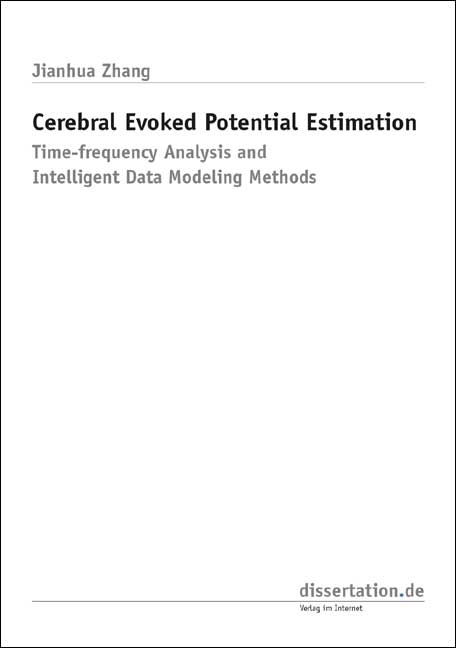
Cerebral Evoked Potential Estimation
Time-frequency Analysis and Intelligent Data Modeling Methods
Seiten
2005
|
1., Aufl.
dissertation.de (Verlag)
978-3-89825-974-3 (ISBN)
dissertation.de (Verlag)
978-3-89825-974-3 (ISBN)
- Titel ist leider vergriffen;
keine Neuauflage - Artikel merken
The cerebral evoked potentials (EPs) are electrical responses of the central nervous system (CNS) to sensory stimuli presented in a well-controlled paradigm. EPs are deeply buried in the spontaneous electroencephalogram (EEG) background activity, whose signal-to-noise-ratio (SNR) is typically less than 0dB (even lower than -60dB sometimes). The nature of poor SNR makes the EP estimation a formidable problem in the past decades in the field of EEG/EP research. It is necessary and of interest to develop more powerful techniques for reliably improving the SNR with much reduced number of trials. The new theoretical contributions of the work are summarized as follows.
A. Due to their multi-resolution analysis (MRA) capacity, wavelet transform and wavelet packet transform methods are systematically explored for estimation and quantitative analysis of the EPs. Mallat’s pyramidal algorithm is used to derive three wavelets and wavelet-packets based de-noising approaches for estimating EP signal in the joint time-frequency domain.
B. The regularization network with an efficient adaptive regularization training rule based on the steepest gradient-descent searching procedure is proposed and then successfully applied to blind EP estimation.
C. A fast algorithm is proposed for optimizing the linear and nonlinear parameters in a general adaptive fuzzy dynamical system, i.e., nonlinear adaptive fuzzy approximator (NAFA). The NAFA is shown to be robust against the noise contaminating the I/O training data and hence applicable to single-trial EP estimation problem, which rejects most parametric model based filtering (or estimation) methods. In particular, we proposed a fast training method by combining Kalman filter and LMS learning for the NAFA model. As far as we know, the proposed NAFA technique is the only published work in which an adaptive fuzzy system is used for the estimation of EPs in a single trial.
The simulations and experiments are performed using simulated and clinical data of visual evoked potentials recorded with a standard recording instrumentation. The feasibility and effectiveness of the time-frequency analysis and intelligent data modeling methods proposed are validated by the simulation and experimental results. The novel EP estimation methods can be used for unambiguous clinical diagnostics.
A. Due to their multi-resolution analysis (MRA) capacity, wavelet transform and wavelet packet transform methods are systematically explored for estimation and quantitative analysis of the EPs. Mallat’s pyramidal algorithm is used to derive three wavelets and wavelet-packets based de-noising approaches for estimating EP signal in the joint time-frequency domain.
B. The regularization network with an efficient adaptive regularization training rule based on the steepest gradient-descent searching procedure is proposed and then successfully applied to blind EP estimation.
C. A fast algorithm is proposed for optimizing the linear and nonlinear parameters in a general adaptive fuzzy dynamical system, i.e., nonlinear adaptive fuzzy approximator (NAFA). The NAFA is shown to be robust against the noise contaminating the I/O training data and hence applicable to single-trial EP estimation problem, which rejects most parametric model based filtering (or estimation) methods. In particular, we proposed a fast training method by combining Kalman filter and LMS learning for the NAFA model. As far as we know, the proposed NAFA technique is the only published work in which an adaptive fuzzy system is used for the estimation of EPs in a single trial.
The simulations and experiments are performed using simulated and clinical data of visual evoked potentials recorded with a standard recording instrumentation. The feasibility and effectiveness of the time-frequency analysis and intelligent data modeling methods proposed are validated by the simulation and experimental results. The novel EP estimation methods can be used for unambiguous clinical diagnostics.
| Reihe/Serie | Dissertation Classic ; 1074 |
|---|---|
| Sprache | englisch |
| Maße | 150 x 210 mm |
| Gewicht | 245 g |
| Einbandart | Paperback |
| Themenwelt | Technik ► Elektrotechnik / Energietechnik |
| Schlagworte | Artificial Neural Network • electroencephalogram (EEG) • evoked potential (EP) • Fuzzy Systems • HC/Technik/Elektronik, Elektrotechnik, Nachrichtentechnik • wavelet transform |
| ISBN-10 | 3-89825-974-9 / 3898259749 |
| ISBN-13 | 978-3-89825-974-3 / 9783898259743 |
| Zustand | Neuware |
| Haben Sie eine Frage zum Produkt? |
Mehr entdecken
aus dem Bereich
aus dem Bereich
Kolbenmaschinen - Strömungsmaschinen - Kraftwerke
Buch | Hardcover (2023)
Hanser (Verlag)
49,99 €


